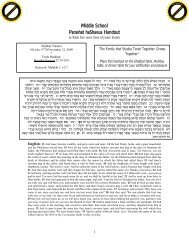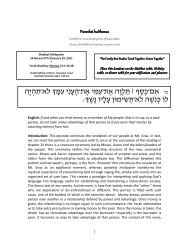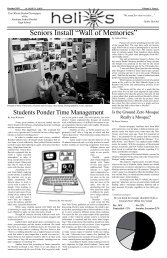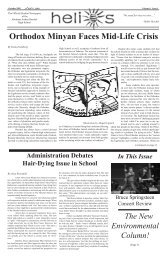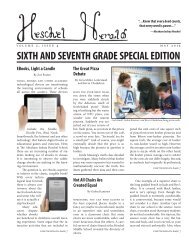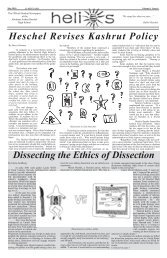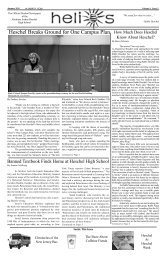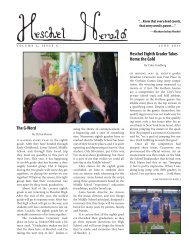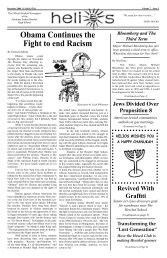Volume 8 Issue 4, February 2010 - The Heschel School
Volume 8 Issue 4, February 2010 - The Heschel School
Volume 8 Issue 4, February 2010 - The Heschel School
You also want an ePaper? Increase the reach of your titles
YUMPU automatically turns print PDFs into web optimized ePapers that Google loves.
Page 6 Helios <strong>Volume</strong> 8 <strong>Issue</strong> 4 <strong>February</strong> <strong>2010</strong><br />
Illustration by Sigal Palley<br />
American Creativity Reduced<br />
to Remakes<br />
(Continued from page 4)<br />
old and new. Senior Jenna Merrin,<br />
lifelong Batman fan, remarked,<br />
“Batman Begins, and later <strong>The</strong> Dark<br />
Knight, brought respect back to Batman's<br />
name. <strong>The</strong>y made him the<br />
dark, somewhat disturbing character<br />
that he is in the comic books and<br />
the original animated series, rather<br />
than the butt of thousands of jokes<br />
that Adam West's Batman or George<br />
Clooney's Batman turned him<br />
into. Batman fans were thoroughly<br />
pleased.”<br />
While these two franchises<br />
did extremely well with their new<br />
installments, other franchises had<br />
less luck with remakes of old movies.<br />
Recently, <strong>The</strong> Pink Panther, <strong>The</strong><br />
Heartbreak Kid, Disney’s A Christmas<br />
Carol and <strong>The</strong> Last House on the<br />
Left all did extremely poorly among<br />
critics and audiences. Perhaps this<br />
comes from a sense of nostalgia –<br />
while a new installment can be either<br />
good or bad without ruining earlier<br />
installments, a remake of a classic<br />
movie can potentially kill all fond<br />
memories of the original.<br />
Junior Esther Lenchner noted, “I<br />
think that when movies are completely<br />
redone, there is a new creative<br />
opportunity for the film maker,<br />
though it is more challenging since<br />
they have to be very creative to not<br />
simply make the same movie.” In<br />
the case of classic and beloved movies,<br />
any change that the film maker<br />
makes in order to differentiate his or<br />
her movie from the original can be<br />
seen as a negative change. <strong>The</strong>refore,<br />
remakes of old movies must be done<br />
with just the right amount of innovation<br />
to the idea and preservation of<br />
the classic movie.<br />
Hollywood is not just remaking<br />
classic movies, but TV shows,<br />
as well. Recently, a slew of remade<br />
shows have been aired, including<br />
Melrose Place, 90210, Battlestar<br />
Galactica, and V. For the most part,<br />
these shows have done resoundingly<br />
well, with large fan bases and critics’<br />
approval. <strong>The</strong> new Battlestar Galactica<br />
is often hailed as far superior to<br />
the original. While the original was a<br />
campy series with cheesy costumes<br />
and sets, the new version is a complex,<br />
beautiful, and meaningful television<br />
show.<br />
Merrin commented, “A new<br />
show doesn't ruin the old show – [it<br />
has] no impact on the previous show.<br />
New shows are different enough that<br />
they don't affect our views of the old<br />
show.”<br />
This sense of separation from<br />
the original series allows television<br />
shows to exist on their own, and not<br />
simply as an extension of an old one.<br />
Creators of televisions shows have<br />
creative license that creators of remade<br />
movies do not.<br />
Even current fashion is becoming<br />
a reflection of the past. Leggings,<br />
high-waisted skirts and pants,<br />
and cardigans are all making a reappearance<br />
on the fashion scene.<br />
Many fashion critics attribute this to<br />
a sense of nostalgia – time has a way<br />
of making fashions of the past appear<br />
more glamorous than they were<br />
at the time. For instance, Hollywood<br />
has made powdered wigs an 18thcentury<br />
fashion staple, while in reality,<br />
they turned hair a dingy shade of<br />
gray and were not completely enjoyable.<br />
In their new versions, fashions<br />
eliminate all the undesirable aspects<br />
and simply become trendy.<br />
Freshman Kate Prince said,<br />
“I hope sixties fashion never comes<br />
back. Some parts of it would be great,<br />
and some parts would be awful.”<br />
As Merrin states, “I think it's a combination<br />
of lack of creativity, laziness,<br />
and lack of confidence [that leads to<br />
franchise reinvigoration.] I'm pretty<br />
sure the mindset is: If something<br />
has already done well, why not do it<br />
again and make money? That way,<br />
[creators] don't have to think of a<br />
new idea, don't have to work all that<br />
hard, and think that they'll get a big<br />
fat paycheck. I think the best phrase<br />
to describe that mindset is EPIC<br />
FAIL.”<br />
Sustainability Committee Reaches<br />
Out to Young Environmentalists<br />
By Emma Goldberg<br />
On January 20, nine members of<br />
the <strong>Heschel</strong> High <strong>School</strong> Sustainability<br />
Committee traveled together to the <strong>Heschel</strong><br />
Lower <strong>School</strong>. <strong>The</strong> Sustainability<br />
Committee was founded at the beginning<br />
of this academic year and dedicates itself<br />
to raising awareness about environmental<br />
issues, such as recycling and energy efficiency.<br />
Bringing their enthusiasm to the<br />
Lower <strong>School</strong>, the Committee partnered<br />
with the fifth grade in working on a recycling<br />
project. Rabbi Anne Ebersman, who<br />
coordinated the event, said, “Our 5th graders<br />
are taking a leadership role in teaching<br />
the rest of the school the rules of recycling<br />
and inspiring students and staff to be more<br />
mindful about recycling.”<br />
To aid the fifth grade in its recycling<br />
goals, each Sustainability Committee<br />
member partnered with a group of<br />
fifth graders; together they prepared instructional<br />
skits about how to recycle. <strong>The</strong><br />
fifth graders presented these skits to every<br />
Lower <strong>School</strong> class later that week.<br />
Twenty-seven years ago, nine<br />
years before any of this year’s seniors<br />
were born, Judith Tumin began her career<br />
at the <strong>Heschel</strong> <strong>School</strong>. At the time, it was<br />
a small, new school, as it had opened in<br />
1983, the same year Judith began teaching<br />
here. When the principal of the school<br />
where she had been teaching, together<br />
with Rabbi Dov, decided to take the job<br />
as principal of the <strong>Heschel</strong> <strong>School</strong>, Judith<br />
followed him, both because “the [<strong>Heschel</strong>]<br />
school sounded wonderful,” and<br />
because she knew the principal was “a<br />
very exciting and interesting educator to<br />
work with.”<br />
While Judith, who is currently<br />
an English teacher and the Ninth Grade<br />
Dean, misses the intimacy and tight community<br />
of <strong>Heschel</strong> in its early years, she<br />
appreciates the different kind of ambience<br />
that the school has to offer today. “I<br />
equally like the bustle of a building with<br />
almost three hundred kids and forty or<br />
fifty staff members,” she says, “<strong>The</strong>re’s<br />
an energy—a breath of opportunity that<br />
didn’t exist then.”<br />
Before becoming a teacher, Judith<br />
worked in publishing for three years.<br />
She then went back to school to get a<br />
Masters degree, and has been a teacher<br />
ever since. “After almost forty years I<br />
still love teaching. I’m happiest in the<br />
classroom. I can’t imagine doing anything<br />
else.”<br />
One of the first rules a student<br />
learns after arriving at <strong>Heschel</strong> is not to<br />
sit in Judith’s chairs. She has four different<br />
chairs strategically placed throughout<br />
the building—one in the teachers’ room,<br />
one in room 322, one in the gym, and one<br />
in her sixth floor office. “This is a very<br />
communal building; we have very few<br />
things that really belong privately to anybody,”<br />
she explained. “This is my chair,<br />
“It was a great experience,” said<br />
sophomore Sasha Gayle Schneider, a member<br />
of the Committee. “I felt like I was educating<br />
the next generation—and partnering<br />
with them—to help our earth.”<br />
<strong>The</strong> Committee members discussed<br />
issues that have arisen regarding recycling,<br />
such as confusion over paper and<br />
plastic recycling, and found that the Lower<br />
<strong>School</strong> shared many of these issues.<br />
This activity was part of a long<br />
process that the Committee has been working<br />
on to reform <strong>Heschel</strong> recycling in both<br />
the Lower and High <strong>School</strong>s.<br />
Said Ethan Finkelstein, co-founder<br />
of the Sustainability Committee, “the<br />
mission of the sustainability committee is<br />
to inspire people to live green. <strong>The</strong> fifth<br />
grade is trying to do so by creating videos<br />
about how to live sustainably and I thought<br />
that it was very meaningful to… see how<br />
such young students care so much about<br />
the environment. I only wish that the students<br />
in our high school could be as driven<br />
and motivated to be green as these young<br />
students are.”<br />
Teacher Profile: Judith Tumin<br />
By Zach Stecker<br />
Photo by Rebecca Leeman<br />
and so I expect students to be respectful<br />
of that.”<br />
Judith is widely known to be a<br />
huge fan both of professional basketball<br />
and of the <strong>Heschel</strong> Heat basketball team.<br />
Having played basketball in high school,<br />
she appreciates the game because “everybody<br />
on the court is doing something. It’s<br />
fast moving. It’s beautiful in its execution.<br />
It’s accessible, and there’s a lot of<br />
it--it’s a very long season!”<br />
Less well known is that Judith<br />
was at Woodstock. She remarked that<br />
it’s one of those life experiences that just<br />
can’t be replicated. “It’s hard to describe<br />
what Woodstock was like. Sometimes you<br />
could get close enough to hear the music<br />
and sometimes you couldn’t; sometimes<br />
it mattered and sometimes it didn’t. But<br />
there’s something about being in mass<br />
crowds who share a constellation of belief<br />
systems…when you’re with people<br />
who are all there for the same reason, it<br />
creates a world of its own.”<br />
Judith enjoys traveling to different<br />
countries on her own. She’s been to<br />
all Western European countries, and visits<br />
friends from her adolescent years in<br />
Israel every few years. She appreciates<br />
flying, and just being in the air; she has<br />
gone parasailing, which she tries to do<br />
whenever she can, and has been in small<br />
gliders.<br />
One might think that, after almost<br />
forty years of teaching and twentyseven<br />
years at the <strong>Heschel</strong> <strong>School</strong>, teaching<br />
might become tedious or monotonous.<br />
But for Judith this is not the case.<br />
“One of the things I like about teaching<br />
so much,” she said, “Is that the chemistry<br />
of the group is different, the individual<br />
kids are different, the energy is often different.<br />
Something has always changed.<br />
Every year is a new year.”



